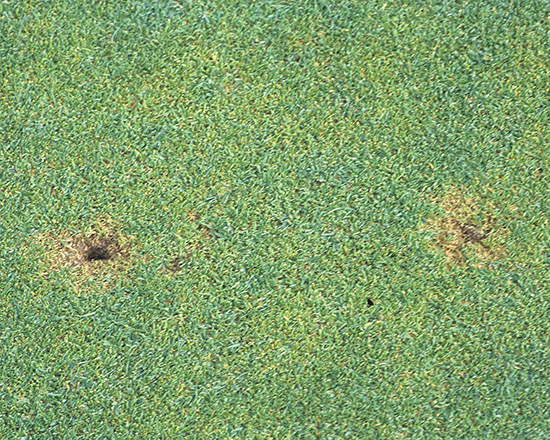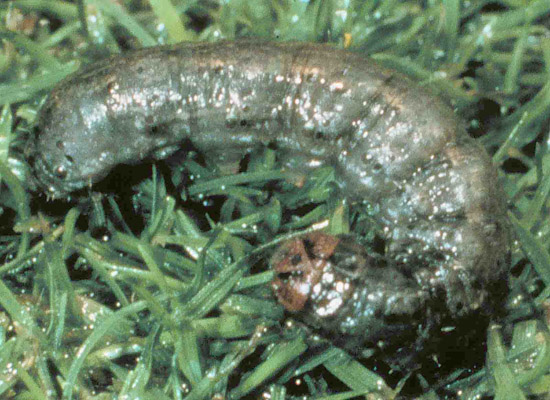Issue 5, June 2, 2014
Black Cutworm
There have been large flights of black cutworm moths into Illinois for several weeks. This insect overwinters in the southern U.S., flying up into the state in the spring. There are several generations per year in Illinois. Golf course personnel should be on the lookout for black cutworm larval infestations in bentgrass, ryegrass, and fescue. They do not cause damage to Kentucky bluegrass as most larvae are unable to survive on it.
Damage on greens appears as circles 2 to 3 inches in diameter where the grass blades are eaten down to the crowns. Frequently, there is a shallow hole in the center of the circle. Cutworm caterpillars feed at night, tending to feed in a circle, as far as they can reach, with their posterior end frequently inserted in a shallow hole. These damaged areas are most numerous within 30 or so feet from the green apron because the older, larger cutworms like to hide in the taller turf around the green during the day, commuting onto the green at night to feed. Feeding damage looks like ball marks where a golf ball skipped across the green, rubbing off the grass blades. Thus, golfers do not recognize the damage as being caused by an insect.

Black cutworm damage to bentgrass.
Additional damage is caused by insect-feeding birds, such as starlings, robins, grackles, cowbirds, and blackbirds. In feeding on the younger cutworms that hide in the thatch of the green, they pull up small divots about one-half inch across. These little divots are large enough to deflect putts, causing golfers to get upset. The sand in these divots also quickly wears the edge of greens mowers blades, causing the blades to require sharpening and replacing more often. Birds feeding on black cutworms can be a hazard at airports.
Damage to lawns is frequently hidden by the taller grass, although lawns may have irregular, roundish, brown areas where the green grass blades have been eaten, revealing the thatch. More commonly, bird damage is obvious. Because lawn turf is rooted deeper and more firmly, it is unlikely to be pulled out by the birds as occurs on golf greens. Instead, round holes about one-half inch in diameter are punched through the turf by the birds' beaks as they search for larvae. Lawns with many cutworms look dingy from a distance due to the brownish to blackish holes where the underlying soil shows.
Black cutworm larvae are dark-colored, heavy-bodied, and up to one-and-one-half inches long. They can be flushed from the turf with a teaspoon of 5% pyrethrum or 1 tablespoon of dishwashing detergent in a gallon of water. Distribute this evenly over a foot square of turf; a watering can works well. Within a couple of minutes, the irritated larvae come up onto the turf surface. Only two to three cutworms per foot square are enough to result in noticeable injury. An application of bifenthrin (Onyx, Talstar), carbaryl (Sevin), chlorantroniliprole (Acelepryn), deltamethrin (DeltaGard), spinosad (Conserve), or trichlorfon (Dylox) controls the caterpillars. Insecticidal nematodes are also effective.

Black cutworm larva.
Cutworm moths lay their eggs near the tip of grass blades, so frequent mowing and clipping removal reduce caterpillar numbers 75 to 97%. Dump clippings baskets well away from greens and other bentgrass areas. Over 90% of the eggs survive the mowing process, so dumping the clippings at the green apron results in caterpillars that can easily attack the green. Homeowners who collect grass clippings and use them to mulch around vegetable plants and flowers concentrate the eggs into smaller areas, resulting in heavy feeding damage from the resulting larvae to their garden plants. Top-dressing the green with sand also reduces the number of cutworm larvae. (Phil Nixon)
Author:
Phil Nixon